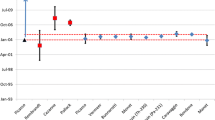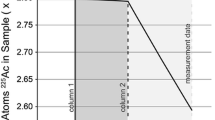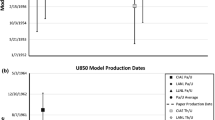Abstract
This article discusses the age dating results of plutonium/uranium chronometers with a focus on the consequences for age plutonium determination when the basic assumptions of the methodology are not fully met: Incomplete removal of the daughter nuclides at the production date and uranium contamination of plutonium samples. In addition to the 238Pu/234U, 239Pu/235U and 240Pu/236U, the 242Pu/238U chronometer is discussed. The 242Pu/238U radiochronometer has only scarcely been used, due to its high sensitivity to residual uranium. However, it can be a very useful indicator for uranium contamination of aged plutonium samples.






Similar content being viewed by others
References
Webb G (2013) Tracking traffickers—the IAEA Incident and Trafficking Database. IAEA Bull 54(2):22
Mayer K, Wallenius M, Fanghänel T (2007) Nuclear forensic science—from cradle to maturity. J Alloys Compd 444–445:50–56
Mayer K, Wellum R (2004) Reference materials for destructive analysis in nuclear safeguards. ESARDA Bull 32:75–82
Wallenius M, Mayer K, Ray I (2006) Nuclear forensic investigations: two case studies. Forensic Sci Int 156:55–62
Wallenius M, Lützenkirchen K, Mayer K, Ray I, de las Heras LA, Betti M, Cromboom O, Hild M, Lynch B, Nicholl A, Ottmar H, Rasmussen G, Schubert A, Tamborini G, Thiele H, Wagner W, Walker C, Zuleger E (2007) Nuclear forensic investigations with a focus on plutonium. J Alloys Compd 444–445:57–62
Pajo L, Schubert A, Aldave L, Koch L, Bibilashvili YK, Dolgov YN, Chorokhov NA (2001) Identification of unknown nuclear fuel by impurities and physical parameters. J Radioanal Nucl Chem 250(1):79–84
Pajo L, Mayer K, Koch L (2001) Investigation of the oxygen isotopic composition in oxidic uranium compounds as a new property in nuclear forensic science. Fresenius J Anal Chem 371(3):348–352
Kraiem M, Richter S, Kühn H, Stefaniak EA, Kerckhove G, Aregbe Y (2011) Investigation of uranium isotopic signatures in real-life particles from a nuclear facility by thermal ionization mass spectrometry. Anal Chem 83(8):3011–3016
Mayer K, Wallenius M, Varga Z (2012) Nuclear forensic science: correlating measurable material parameters to the history of nuclear material. Chem Rev 113(2):884–900
Stepanov SI, Chekmarev AM (2008) Concept of spent nuclear fuel reprocessing. Dokl Chem 423(1):276–278
Wallenius M, Mayer K (2000) Age determination of plutonium material in nuclear forensics by thermal ionisation mass spectrometry. Fresenius J Anal Chem 366(3):234–238
Mayer K, Wallenius M, Hedberg M, Lützenkirchen K (2009) Unveiling the history of seized plutonium through nuclear forensic investigations. Radiochim Acta 97(4–5):261–264
Stolz W (2005) Radioaktivität: Grundlagen—Messung—Anwendungen Vieweg + Teubner Verlag
Keegan RP, Gehrke RJ (2003) A method to determine the time since last purification of weapons grade plutonium. Appl Radiat Isot 59(2–3):137–143
Nguyen CT (2006) Verification of the 239Pu content, isotopic composition and age of plutonium in Pu–Be neutron sources by gamma-spectrometry. Nucl Instrum Methods Phys Res Sect B 251(1):227–236
Ramebäck H, Nygren U, Tovedal A, Ekberg C, Skarnemark G (2012) Uncertainty assessment in gamma spectrometric measurements of plutonium isotope ratios and age. Nucl Instrum Methods Phys Res Sect B 287:56–59
Kirby HW, Sheehan WE (1984) Determination of 238Pu and 241Am in 239Pu by alpha-spectrometry. Nucl Instrum Methods 223(2–3):356–359
Zhang H-T, Zhu FR, Xu J, Dai YH, Li DM, Yi XW, Zhang LX, Zhao YG (2008) Age determination of plutonium material by alpha spectrometry and thermal ionization mass spectrometry. Radiochim Acta 96(6):327–331
Varga Z, Surányi G, Vajda N, Stefánka Z (2007) Determination of plutonium and americium in environmental samples by inductively coupled plasma sector field mass spectrometry and alpha spectrometry. Microchem J 85(1):39–45
Chen Y, Chang Z-y, Zhao Y-g, Zhang J-l, Li J-h, Shu F-j (2009) Studies on the age determination of trace plutonium. J Radioanal Nucl Chem 281(3):675–678
Nygren U, Ramebäck H, Nilsson C (2007) Age determination of plutonium using inductively coupled plasma mass spectrometry. J Radioanal Nucl Chem 272(1):45–51
Wallenius M, Tamborini G, Koch L (2001) The “age” of plutonium particles. Radiochim Acta 89 (1_2001):55
Uriano GA (1982) National Bureau of Standards Certificate of Analysis Standard Reference Material 946 Plutonium Isotopic Standard. U.S. Department of Energy, Washington, DC
IAEA (1986) Decay data of the Transactinium Nuclides. Technical Reports Series No. 261
Wellum R, Verbruggen A, Kessel R (2009) A new evaluation of the half-life of 241Pu. J Anal At Spectrom 24(6):801–807
De Bièvre P, Peiser HS (1997) Basic equations and uncertainties in isotope-dilution mass spectrometry for traceability to SI of values obtained by this primary method. Fresenius J Anal Chem 359(7):523–525
Emons H (2011) Certificate Spike Isotopic Reference Material IRMM-049d Institute for Reference Materials and Measurements. Geel, Belgium
De Bièvre P (1997) Certificate Spike Isotopic Reference Material IRMM-049c Institute for Reference Materials and Measurements. Geel, Belgium
Richter S, Alonso A, Aregbe Y, Eykens R, Kehoe F, Kühn H, Kivel N, Verbruggen A, Wellum R, Taylor PDP (2009) A new series of uranium isotope reference materials for investigating the linearity of secondary electron multipliers in isotope mass spectrometry. Int J Mass Spectrom 281(3):115–125
Jakopič R, Verbruggen A, Eykens R, Kehoe F, Kühn H, Kushigeta Y, Jacobsson U, Bauwens J, Richter S, Wellum R, Aregbe Y (2010) An inter-calibration campaign using various selected Pu spike isotopic reference materials. J Radioanal Nucl Chem 286(2):449–454
Callis EL, Abernathey RM (1991) High-precision isotopic analyses of uranium and plutonium by total sample volatilization and signal integration. Int J Mass Spectrom Ion Processes 103(2–3):93–105
Jakopic R, Richter S, Kühn H, Benedik L, Pihlar B, Aregbe Y (2009) Isotope ratio measurements of pg-size plutonium samples using TIMS in combination with “multiple ion counting” and filament carburization. Int J Mass Spectrom 279(2–3):87–92
Taylor P, Wellum R (2006) Certificate isotopic reference material IRMM-074 Institute for Reference Materials and Measurements. Geel, Belgium
De Bièvre P (1996) Certificate Isotopic Reference Material IRMM-290b Institute for Reference Materials and Measurements. Geel, Belgium
Gourgiotis A, Granet M, Isnard H, Nonell A, Gautier C, Stadelmann G, Aubert M, Durand D, Legand S, Chartier F (2010) Simultaneous uranium/plutonium separation and direct isotope ratio measurements by using CO2 as the gas in a collision/reaction cell based MC-ICPMS. J Anal At Spectrom 25(12):1939–1945
Mason P (2010) A documentary history of the United States’ first plutonium isotopic reference materials. Paper presented at the 51st Annual INMM Meeting Baltimore
De Laeter JR, Boelke JK, De Bievre P, Hidaka H, Peiser HS, Rosman KJR, Taylor PDP (2003) Atomic weights of the elements: review 2000 (IUPAC Technical Report). Pure Appl Chem 75(6):683–800
IAEA (2007) Management of reprocessed uranium—current status and future prospects. IAEA Technical Documents (IAEA-TECDOC-1529)
Bleise A, Danesi PR, Burkart W (2003) Properties, use and health effects of depleted uranium (DU): a general overview. J Environ Radioact 64(2–3):93–112
Boulyga SF, Testa C, Desideri D, Becker JS (2001) Optimisation and application of ICP-MS and alpha-spectrometry for determination of isotopic ratios of depleted uranium and plutonium in samples collected in Kosovo. J Anal At Spectrom 16(11):1283–1289
Smith DK, Kristo MJ, Niemeyer S, Dudder GB (2008) Documentation of a model action plan to deter illicit nuclear trafficking. J Radioanal Nucl Chem 276(2):415–419
Neuhoff J (2008) Certificate of analysis CRM U500 uranium isotopic standard. U.S. Department of Energy, Washington, DC
Glaser A (2002) The conversion of research reactors to low-enriched fuel and the case of the FRM-II. Sci Glob Secur 10(1):61–79
Ma C, von Hippel F (2001) Ending the production of highly enriched uranium for naval reactors. Nonprolif Rev (Spring 2001) 8:8
Aggarwal SK, Saxena MK, Shah PM, Kumar S, Jairaman U, Jain HC (1994) Studies on the evaporation and ionisation behaviour of uranium and plutonium in thermal ionisation mass spectrometry. Int J Mass Spectrom Ion Process 139:111–126
Be M, Chiste V, Dulieu C (2006) Halve-lives, Table of recommended values. Laboratoire National Henri Becquerel Note Technique (DETECS/LNHB/2006-58)
Varga Z, Nicholl A, Wallenius M, Mayer K (2012) Development and validation of a methodology for uranium radiochronometry reference material preparation. Anal Chim Acta 718:25–31
Acknowledgments
The authors would like to thank Rüdiger Kessel for providing for the program GUM work bench 2.4 (Metrodata, Germany) for the uncertainty evaluation and Frances Kehoe, Roger Eykens and Heinz Kuehn for their support in the IRMM nuclear chemistry and mass spectrometry laboratories.
Author information
Authors and Affiliations
Corresponding author
Rights and permissions
About this article
Cite this article
Sturm, M., Richter, S., Aregbe, Y. et al. Evaluation of chronometers in plutonium age determination for nuclear forensics: What if the ‘Pu/U clocks’ do not match?. J Radioanal Nucl Chem 302, 399–411 (2014). https://doi.org/10.1007/s10967-014-3294-8
Received:
Published:
Issue Date:
DOI: https://doi.org/10.1007/s10967-014-3294-8




